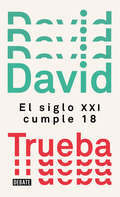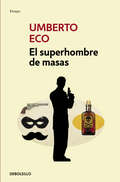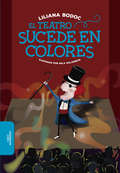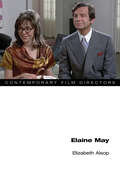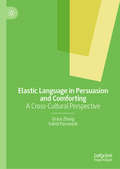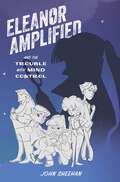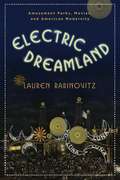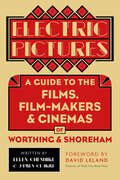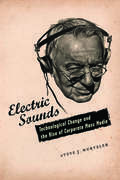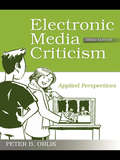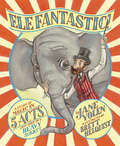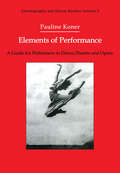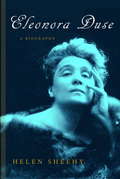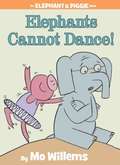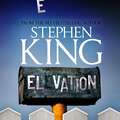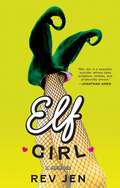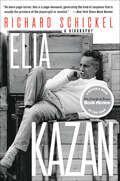- Table View
- List View
El secreto de Selena: La reveladora historia detrás su trágica muerte (Atria Espanol)
by María Celeste ArrarásEdición 20 aniversario Un retrato íntimo e investigativo del asesinato de la querida reina de la música tejana, Selena Quintanilla Pérez, escrito por la galardonada periodista María Celeste Arrarás. Ahora, con un nuevo introducción y epílogo por la vigésima edición de aniversarioNo hay duda de que Yolanda Saldívar disparó la bala que mató a Selena el 31 de Marzo de 1995, pero ¿alguien sabe lo que realmente sucedió en la habitación 158 del hotel Days Inn, momentos antes de que el crimen se llevara a cabo? María Celeste Arrarás tiene muchas respuestas. Su cobertura de la muerte, el juicio y el drama detrás de la tragedia la convirtió en la experta indiscutible del caso de Selena. Arrarás comparte detalles de primera mano sobre el crimen y las personas involucradas. Incluyendo la polémica entrevista en la cárcel con Yolanda, que en repetidas ocasiones habló sobre “el secreto de Selena”, una insólita información que Saldívar mantuvo oculta durante y después del juicio pero que sí le reveló a Arrarás. Muchas preguntas quedaron sin respuesta hasta la publicación de la citada entrevista. ¿Por qué hubo una maleta llena de ropa de Selena en la escena del crimen? ¿Cuál fue el significado del anillo de piedras preciosas, adornado con la S inicial que cayó del puño ensangrentado de Selena? ¿Quién era el médico de Monterrey que se hacía llamar asesor de Selena? María Celeste le ha seguido la pista al caso durante dos décadas y logro encajar las piezas de este rompecabezas. El secreto de Selena revela lo que realmente sucedió aquel lluvioso día de marzo.
El siglo XXI cumple 18
by David TruebaUna reveladora recopilación de artículos con la que David Trueba pasa revista a los primeros dieciocho años de nuestro siglo. «Hay cosas que pasan y que de tanto pasar terminan por definir los tiempos mucho mejor que las teorías.» Con estas palabras, el novelista, cineasta y periodista David Trueba sintetiza el cometido de esta recopilación de artículos periodísticos. Los artículos se centran en hechos, no en opiniones, y analizan los verdaderos significantes de nuestro tiempo. Porque cuando el siglo XXI llega a la mayoría de edad, ya no se trata de analizar los cambios y escuchar los latidos renovadores: nos encontramos ante algo ya impuesto, ante una nueva manera de ser. De entre los sucesos que marcan estos dieciocho años de vida de nuestro siglo, Trueba destaca la emigración y su impacto en los miedos colectivos; la identidad tanto sexual e íntima como nacional y colectiva; la crisis de la democracia y sus representaciones cotidianas, reducidas a lo electoral y sus alternancias; y, finalmente, la transformación tecnológica con el consiguiente impacto en el empleo y la economía de a pie. El siglo XXI cumple 18 se convierte así en una revisión de algunos de los asuntos de la actualidad que más nos perturban y que, nos guste o no, están aquí para quedarse.
El superhombre de masas: Retórica E Ideología En La Novela Popular (Ensayo Ser. #Vol. 237)
by Umberto EcoUn análisis exhaustivo de los personajes que aparecen en las novelas. «Creo que se puede afirmar que la pretendida superhumanidad de Nietzsche tiene por origen y modelo doctrinal no a Zaratustra, sino al conde de Montecristo de Dumas.» Eco parte de esta afirmación de Gramsci para estudiar a los superhombres de las novelas populares, de Rocambole a Montecristo, de Arsène Lupin a James Bond, de Tarzán a Superman, sin olvidar a Rodolphe de Gerolstein, el príncipe de Los misterios de París. ¿Por qué y cómo se leen las novelas folletinescas? ¿Qué mecanismos entran en juego en su estructura narrativa? ¿Cómo funciona la ideología de la consolación (el héroe consuela al lector de no ser un superhombre)? Estas son algunas de las preguntas que se plantea Umberto Eco en esta recopilación de ensayos magistrales. La crítica ha dicho... «No es solo un punto de referencia imprescindible a la hora de enfrentarse al vasto mundode la literatura popular, es también una delicia por su chispeante estilo.»Joaquín Marco, ABC «Uno de los pensadores más influyentes de nuestro tiempo.»Los Angeles Times
El teatro sucede en colores (Alfaguara Vuelve A Las Escuelas Ser.)
by Liliana BodocVersión teatral del libro Sucedió en colores. Cinco actos que nos conectan con las emociones y sentimientos profundos. Ideales para leer; disfrutar y también para representar en su versión de teatro. El libro es una invitación a leer teatro y a representar una pieza teatral. Inicia con una introducción "El teatro no es cuento"; que acerca a los lectores a la versión teatral de Sucedió en colores. En el acto ROJO; un diablo se enamora de la más hermosa de las vendedoras de manzanas del Mercado de las Rosas. Pero para que su amor se concrete tendrá que recibir por respuesta solo tres "Sí" de la encantadora muchacha. "Solo tres Sí"; ni una palabra más; ni una menos. En BLANCO; a la hora de los cuentos; un abuelo esquimal relata historias a sus nietos. Y la noche se llena de luna; luna del oso; luna entera; luna de lobo y luna muerta. Porque así es como se suceden las lunas en el cielo. Y luego se suceden tres relatos más; cada uno teñido de un color y de emociones intensas. Así se van sucediendo los colores, negro; amarillo y verde hasta conformar una pieza sensible y con personajes entrañables. Cada acto va creando un universo de juego; potencia la imaginación y la fantasía.
El universo cinematográfico de Marvel Cronología oficial (The Marvel Cinematic Universe An Official Timeline): Cronología oficial
by Amy RatcliffeLa enciclopedia definitiva que ordena de forma cronológica todas las películas y series del Universo Cinematográfico de Marvel y te ayudará a entender qué ocurrió, cuándo, dónde y por qué.Tierras y universos distintos, saltos temporales, tramas que se cruzan, realidades alternativas… Con tantas películas, series, personajes e historias distintas, la cronología y el hilo argumental del Universo Cinematográfico de Marvel son cada vez más y más complejos de seguir. ¡No desesperes! Esta cronología oficial, creada en colaboración con Marvel Studios, te brinda todas las respuestas para comprender cómo empezó todo y entender cada una de las fases de la saga.Sigue la historia del UCM, desde el Big Bang hasta las consecuencias del Blip, y conoce más sobre los orígenes y las características de sus héroes, la evolución de las armaduras de Iron Man, la búsqueda de las Gemas del Infinito o la formación del Multiverso. Con cientos de fotografías de las películas y series del UCM, infografías y líneas temporales.Incluye un detallado índice para encontrar fácilmente la cronología y los saltos temporales, y conocer los escenarios, los personajes y los sucesos principales.Un libro imprescindible para los amantes del universo Marvel que desvela los secretos de la mayor saga de superhéroes jamás creada.------------------------------------------------Become a master of the Marvel Cinematic Universe!The Marvel Cinematic Universe (MCU) is vast, incredibly varied, and richly complex. Different worlds, different timelines, countless characters. This is the guide to that universe. Created in close collaboration with Marvel Studios, it will frame the MCU’s biggest events: what happened, when, where, and why. Follow the entire story of the MCU from before the Big Bang to the Blip and beyond. Along the way, learn more about the evolution of the Iron Man armors, the hunt for the Infinity Stones, and the formation of The Multiverse. The Marvel Cinematic Universe An Official Timeline features: Hundreds of high-quality movie stills. A detailed index so fans can quickly research the timelines of key props, characters, and story arcs.A treasured keepsake for any movie buff, filled with exclusive infographics, illuminating timelines, and amazing movie stills, this book will have pride of place on any MCU fan’s shelf.
Elaine May (Contemporary Film Directors)
by Elizabeth AlsopA master of subverting tropes with surgical precision, Elaine May forged a career in 1970s Hollywood with films like The Heartbreak Kid and Mikey and Nicky. Elizabeth Alsop explores the director’s non-conformist and uncompromising vision while looking at May’s films against trends in classic and post-classical Hollywood. Shaped by her background and success in the theater, May brought the biting humor of her improv comedy to her filmmaking. But unfriendly media and a system hostile to both her methods and sensibility consigned her to “director’s jail” after the failure of Ishtar. As Alsop moves through the filmmaker’s four movies, she tracks May’s inventive treatment of favorite themes like hapless male characters and the inanities of American culture. She also considers May’s work in relation to her multifaceted career as a writer and performer. A compelling reconsideration of an iconoclast and original, Elaine May reveals how a surprisingly radical auteur created her trademark cinema of discomfort.
Elastic Language in Persuasion and Comforting: A Cross-Cultural Perspective
by Grace Zhang Vahid ParvareshThis innovative book examines the discourse of reality television, and the elasticity of language in the popular talent show The Voice from a cross-cultural perspective. Analysing how and why elastic language is used in persuasion and comforting, a comparison between Chinese and English is made, and the authors highlight the special role that elastic language plays in effective interactions and strategic communication. Through the lens of the language variance of two of the world’s most commonly spoken languages, the insights and resources provided by this book are expected to advance knowledge in the fields of contrastive pragmatics and cross-cultural communication, and inform strategies in bridging different cultures. This study highlights the need to give the elastic use of language the attention it deserves, and reveals how language is non-discrete and strategically stretchable. This book will be of interest to academics and postgraduate students engaged in elastic/vague language studies, cross-cultural pragmatics, media linguistics, discourse analysis, sociolinguistics and communication studies.
Eleanor Amplified and the Trouble with Mind Control
by John SheehanBased on the popular children's podcast, follow Eleanor Amplified as she teams up with middle school reporter Miku to get the scoop and save the day!Join world-renowned investigative reporter Eleanor Amplified as she goes undercover to help a student reporter and fan, Miku Tangeroa, expose the corruption at her middle school. Together they discover that the new organic lunch program and tech-based learning systems are doing more harm than good and might actually be part of an evil plot that might put all of Union City in danger. Can Eleanor, Miku, and their friends get to the bottom of these suspicious events in time? Just who is behind SmartFüdz and the Mesmerosin Extractor? Will Eleanor survive the hallways—and students—of Brighton Middle School? Find out in the latest adventure of Eleanor Amplified!With radio-drama like action, outrageous villains, and a tough, intelligent female protagonist to boot, readers follow Eleanor and Miku as they foil devious plots and outwit crafty villains, all in pursuit of the big story. Written by John Sheehan, the creator of the popular podcast Eleanor Amplified, this entertaining and informative book, like the podcast, is intended to spark laughter and conversation, while preparing kids to appreciate journalism and make smart media choices in the future. With the help of Eleanor and Miku, readers can use this novel as inspiration to go out and find the next big scoop for themselves!
Electra and Other Plays
by EuripidesWritten during the fierce struggle for supremacy between Sparta and Euripides' native Athens, these five plays are haunted by the shadow of war - and in particular its impact on women. In Electra, the children of Agamemnon take bloody revenge on their mother for murdering their father after his return from Troy, and Suppliant Women depicts the grieving mothers of those killed in battle. The other plays deal with the aftermath of the Trojan War for the defeated survivors, as Andromache shows Hector's widow as a trophy of war in the house of her Greek captor, and Hecabe portrays a defeated queen avenging the murder of her last-remaining son, while Trojan Women tells of the plight of the city's women in the hands of the victors. Translated by John Davie and with an introduction and notes by Richard Rutherford
Electric Dreamland: Amusement Parks, Movies, and American Modernity (Film and Culture Series)
by Lauren RabinovitzAmusement parks were the playgrounds of the working class in the early twentieth century, combining numerous, mechanically-based spectacles into one unique, modern cultural phenomenon. Lauren Rabinovitz describes the urban modernity engendered by these parks and their media, encouraging ordinary individuals to sense, interpret, and embody a burgeoning national identity. As industrialization, urbanization, and immigration upended society, amusement parks tempered the shocks of racial, ethnic, and cultural conflict while shrinking the distinctions between gender and class. Following the rise of American parks from 1896 to 1918, Rabinovitz seizes on a simultaneous increase in cinema and spectacle audiences and connects both to the success of leisure activities in stabilizing society. Critics of the time often condemned parks and movies for inciting moral decline, yet in fact they fostered women's independence, racial uplift, and assimilation. The rhythmic, mechanical movements of spectacle also conditioned audiences to process multiple stimuli. Featuring illustrations from private collections and accounts from unaccessed archives, Electric Dreamland joins film and historical analyses in a rare portrait of mass entertainment and the modern eye.
Electric Pictures: A Guide to the Films, Film-Makers & Cinemas of Worthing & Shoreham
by James Clarke Ellen Cheshire David LelandWritten as part of the Worthing WOW festival celebrations, Electric Pictures commemorates 120 years of film in the Sussex coastal towns of Worthing and Shoreham, capturing the region’s rich cinematic legacy and its place in British film history. From film-making pioneers through to blockbuster films and key events in the film history of the coast, this volume draws on research from film archives and local history resources to tell the story of the south coast film world. Richly illustrated and featuring contributions from local historians and film and theatre specialists, this book also includes an additional Heritage Trail guide that reveals key filming locations and the towns’ cinemas.
Electric Sounds: Technological Change and the Rise of Corporate Mass Media
by Stephen WurtzlerA history of sound recording and reproduction and how this technology transformed American mass media.
Electric Sounds: Technological Change and the Rise of Corporate Mass Media (Film and Culture Series)
by Steve WurtzlerElectric Sounds brings to vivid life an era when innovations in the production, recording, and transmission of sound revolutionized a number of different media, especially the radio, the phonograph, and the cinema. The 1920s and 1930s marked some of the most important developments in the history of the American mass media: the film industry's conversion to synchronous sound, the rise of radio networks and advertising-supported broadcasting, the establishment of a federal regulatory framework on which U.S. communications policy continues to be based, the development of several powerful media conglomerates, and the birth of a new acoustic commodity in which a single story, song, or other product was made available to consumers in multiple media forms and formats.But what role would this new media play in society? Celebrants saw an opportunity for educational and cultural uplift; critics feared the degradation of the standards of public taste. Some believed acoustic media would fulfill the promise of participatory democracy by better informing the public, while others saw an opportunity for manipulation. The innovations of this period prompted not only a restructuring and consolidation of corporate mass media interests and a shift in the conventions and patterns of media consumption but also a renegotiation of the social functions assigned to mass media forms. Steve J. Wurtzler's impeccably researched history adds a new dimension to the study of sound media, proving that the ultimate form technology takes is never predetermined. Rather, it is shaped by conflicting visions of technological possibility in economic, cultural, and political realms. Electric Sounds also illustrates the process through which technologies become media and the ways in which media are integrated into American life.
Electronic Media Criticism: Applied Perspectives (3rd Edition)
by Peter B. OrlikElectronic Media Criticism introduces readers to a variety of critical approaches to audio and video discourse on radio, television and the Internet. The book applies key aesthetic, sociological, philosophical, psychological, structural and economic principles to arrive at a comprehensive evaluation of both programming and advertising content. It includes numerous critiques to illustrate the ways in which critical expression can be structured, providing readers with feasible and flexible tools for focused and rational analysis of electronic media product as well as enhanced understanding of the role and essential ingredients of criticism itself. These insights range from the perceptions of Plato and Aristotle to the research that motivates twenty-first century marketing and advertising.
Elefantastic!: A Story of Magic in 5 Acts: Light Verse on a Heavy Subject
by Jane YolenExperience a magical story of ele-friendship and one disappearing elephant's ele-fate.Discover the unlikely—and entirely unforgettable—friendship between Flora, an elephant calf stolen from her African home, and David, the circus impresario and magician who adopts, trains, and ultimately liberates her, in this tale freely inspired by actual events.With a minimum of language—only 22 words in all—but a maximum of inventive ele-fantabulous wordplay, Jane Yolen deftly reimagines this initially tentative but ultimately unconditional relationship between a man and an elephant. Brett Helquist not only lovingly illuminates the tale with all the excitement and tension, mystery and color of a vintage circus poster but also fully captures the subtle range of emotions of a remarkable and enduring ele-friendship.FRIENDSHIP TALE: There's endless fascination with the deep bond of friendship that can grow between wild animals and humans. This spectacular narrative is based on the true story of Flora the elephant, which can be read in the back of the book.READ-TOGETHER WHIMSY AND WIT: A simple text in which every word starts with ELE- makes this a great read-aloud and guessing game that will have children completing the whimsical text.EVERYONE LOVES ELEPHANTS: From Babar to Elmer, elephants have been icons of children's literature and continue to be one of the most popular animals featured in contemporary children's books. This book is perfect for Elephant-fans of all ages!Perfect for:• Lovers of animal friendship stories• Grandparents• Parents• The myriad fans of Jane Yolen• Teachers and educators• Librarians
Elegy for Theory
by D. N. RodowickRhetorically charged debates over theory have divided scholars of the humanities for decades. In Elegy for Theory, D. N. Rodowick steps back from well-rehearsed arguments pro and con to assess why theory has become such a deeply contested concept. Far from lobbying for a return to the "high theory" of the 1970s and 1980s, he calls for a vigorous dialogue on what should constitute a new, ethically inflected philosophy of the humanities. Rodowick develops an ambitiously cross-disciplinary critique of theory as an academic discourse, tracing its historical displacements from ancient concepts of theoria through late modern concepts of the aesthetic and into the twentieth century. The genealogy of theory, he argues, is constituted by two main lines of descent--one that goes back to philosophy and the other rooted instead in the history of positivism and the rise of the empirical sciences. Giving literature, philosophy, and aesthetics their due, Rodowick asserts that the mid-twentieth-century rise of theory within the academy cannot be understood apart from the emergence of cinema and visual studies. To ask the question, "What is cinema?" is to also open up in new ways the broader question of what is art. At a moment when university curriculums are everywhere being driven by scientism and market forces, Elegy for Theory advances a rigorous argument for the importance of the arts and humanities as transformative, self-renewing cultural legacies.
Elektra
by Yvonne Navarro Zak Penn Stuart J. Zicherman Raven MetznerElektra Natchios died, once. But the beautiful, dangerous heiress was resurrected and recruited by a mysterious group who trained Elektra in the art of combat, then cast her out when her anger and lust for vengeance became more than they could bear. Now she works as a paid assassin -- the very best that money can buy, notorious for her lethal speed and precision. Elektra is careful to treat each assignment as just another job, providing a service she can perform better than anyone else. When Elektra is hired to eliminate an attractive, friendly widower and his young daughter, she finds that things aren't so simple anymore. Soon Elektra is engaged in an all-out war with the powerful criminal organization known as The Hand for the lives of one man and his child -- but the ultimate struggle may be for Elektra's soul....
Elements of Music (3rd Edition)
by Joseph StrausThis music fundamentals textbook is for both aspiring music majors and non-majors. Based on an anthology of works from music literature, it features clear, concise explanations, extensive written exercises, and a variety of suggested in-class activities. It emphasizes process of making music-emphasizing, at every stage, that music is to be heard and made-not merely seen and learned in the abstract. All of the key topics are covered: music notation; rhythm; scales; intervals; triads; basic harmonic progressions. Several supplements are available for this text. An Audio CD is available including performances of key works analyzed in the text. The examples are also available in Finale files on MySearchLab so that students can directly work on exercises on their computers. Teaching and Learning Experience Personalize Learning- MySearchLab features all of Straus' exercises online. Students can do their exercises on their computers, using Finale, the top music notation software. Using this software, students will be able to hear the music they are writing as they write it. MySearchLab also offers further learning reinforcement with flashcards, chapter learning objectives, and chapter quizzes. Additional exercises that ask the student to identify key musical concepts are available online for student self-drills. Improve Critical Thinking-Written exercises and assignments both in traditional written and electronic formats reinforce concepts. Engage Students-In-class activities, including singing, dictation, and keyboard exercises are designed to supplement and reinforce the theory lessons. Support Instructors-Supported by the best instructor resources on the market; MySearchLab and an Instructor's Manual
Elements of Performance: A Guide for Performers in Dance, Theatre and Opera (Choreography and Dance Studies Series)
by Pauline KonerFirst Published in 1992. Routledge is an imprint of Taylor & Francis, an informa company.
Eleonora Duse: A Biography
by Helen SheehyA new biography, the first in two decades, of the legendary actress who inspired Anton Chekhov, popularized Henrik Ibsen, and spurred Stanislavski to create a new theory of acting based on her art and to invoke her name at every rehearsal. Writers loved her and wrote plays for her. She befriended Rainer Maria Rilke and inspired the young James Joyce, who kept a portrait of her on his desk. Her greatest love, the poet d'Annunzio, made her the heroine of his novel Il fuoco (The Flame). She radically changed the art of acting: in a duel between the past and the future, she vanquished her rival, Sarah Bernhardt. Chekhov said of her, "I've never seen anything like it. Looking at Duse, I realized why the Russian theatre is such a bore. " Charlie Chaplin called her "the finest thing I have seen on the stage. " Gloria Swanson and Lillian Gish watched her perform with adoring attention, John Barrymore with awe. Shaw said she "touches you straight on the very heart." When asked about her acting, Duse responded that, quite simply, it came from life. Except for one short film, Duse's art has been lost. Despite dozens of books about her, her story is muffled by legend and myth. The sentimental image that prevails is of a misty, tragic heroine victimized by men, by life; an artist of unearthly purity, without ambition. Now Helen Sheehy, author of the much admired biography of Eva Le Gallienne, gives us a different Duse--a woman of strength and resolve, a woman who knew pain but could also inflict it. "Life is hard," she said, "one must wound or be wounded." She wanted to reveal on the stage the truth about women's lives and she wanted her art to endure. Drawing on newly discovered material, including Duse's own memoir, and unpublished letters and notes, Sheehy brings us to an understanding of the great actress's unique ways of working: Duse acting out of her sense of her character's inner life, Duse anticipating the bold aspects of modernism and performing with a sexual freedom that shocked and thrilled audiences. She edited her characters' lines to bare skeletons, asked for the simplest sets and costumes. Where other actresses used hysterics onstage, Duse used stillness. Sheehy writes about the Duse that the actress herself tried to hide--tracing her life from her childhood as a performing member of a family of actors touring their repertory of drama and commedia dell'arte through Italy. We follow her through her twenties and through the next four decades of commissioning and directing plays, running her own company, and illuminating a series of great roles that included Emile Zola's Thérèse Raquin, Marguerite in Dumas's La Dame aux camélias, Nora in Ibsen's A Doll's House, and Hedda in his Hedda Gabler. When she thought her beauty was fading at fifty-one, she gave up the stage, only to return to the theatre in her early sixties; she traveled to America and enchanted audiences across the country. She died as she was born--on tour. Sheehy's illuminating book brings us as close as we have ever been to the woman and the artist.
Elephant Song (Circus World #3)
by Barry B. LongyearCITY OF BARABOO told how O'Hara's greater shows headed for the stars, elephants and all, in search of new worlds to conquer and delight. CIRCUS WORLD told how centuries later a planet peopled by acrobats, fortune-hunters and freaks, fought to save their unique civilization based on showmanship. ELEPHANT SONG tells what happened in between. From the crash of the starship City of Baroboo on Momus, to the day the last elephant is gone... and the men and women of Circus World realize that this engagement is forever... City of Baraboo and Circus World are in the Bookshare Library.
Elephants Cannot Dance! (An Elephant and Piggie Book)
by Mo WillemsMeet Elephant Gerald and Piggie. <br>Gerald is careful. Piggie is not. <br>Piggie cannot help smiling. Gerald can. <br>Gerald worries so that Piggie does not have to. <br>Gerald and Piggie are best friends. <br>In Elephants Cannot Dance! Piggie tries to teach Gerald some new moves. But will Gerald teach Piggie something even more important? <P><P><i>Advisory: This book offers only partial accessibility. We have kept it in the collection because it is useful for some of our members. Benetech is actively working on projects to improve accessibility issues such as these in the future.</i>
Elevation
by Stephen KingSet in Castle Rock, ELEVATION is moving story about a man whose mysterious affliction brings a small town together.Castle Rock is a small town, where word gets around quickly. That's why Scott Carey wants to confide only in his friend Doctor Bob Ellis about his strange condition: he's losing weight, without getting thinner, and the scales register the same when he is in his clothes or out of them, however heavy they are. Scott also has new neighbours, who have opened a 'fine dining experience' in town, although it's an experience being shunned by the locals; Deidre McComb and her wife Missy Donaldson don't exactly fit in with the community's expectations. And now Scott seems trapped in a feud with the couple over their dogs dropping their business on his lawn. Missy may be friendly, but Deidre is cold as ice.As the town prepares for its annual Thanksgiving 12k run, Scott starts to understand the prejudices his neighbours face and he tries to help. Unlikely alliances form and the mystery of Scott's affliction brings out the best in people who have indulged the worst in themselves and others.From master storyteller Stephen King, our 'most precious renewable resource, like Shakespeare in the malleability of his work' (Guardian), comes this timely, upbeat tale about finding common ground despite deep-rooted differences. Compelling and eerie, Elevation is as gloriously joyful (with a twinge of deep sadness) as 'It's a Wonderful Life.' (P)2018 Simon & Schuster Audio
Elf Girl
by Rev JenMeet Rev Jen, patron saint of the uncool, cheerleader for nonconformists, geeks, and oddballs the world over. From her tiny rent-controlled apartment on Manhattan's hip Lower East Side, she holds court over a wacky cast of friends and lovers with an unchecked candor that makes her impossible not to love. Zany and wry, Rev Jen will charm readers with these fun and irreverent true stories of her meteoric rise from art school misfit to neighborhood celebrity and all-around good-time gal. Whether she is dressing up as Doo-Doo, the hard-drinking Teletubby who's been expelled from Teletubbyland, or starring in her one-woman musical Rats, the shortest running show on Broadway, Jen's quirky humor and genuine heart make Elf Girl an anthem for misfits everywhere. f, which received a starred review from Publishers Weekly and was hailed as a must-read by Bust magazine, The Village Voice, Bookslut.com, and many more, Elf Girl is infused with Jen's zany sense of humor and a surprising amount of heart. Featuring an Introduction by Bored to Death creator Jonathan Ames, who even based a character on Rev Jen (elf ears and all!) in the HBO hit show's second season, this is an anthem for dorky girls everywhere--a sharply observant and entertaining memoir.
Elia Kazan: A Biography
by Richard Schickel“No mere page-turner, this is a page-devourer, generating the kind of suspense that is usually the province of the playwright or novelist.” —The New York Times Book ReviewFew figures in film and theater history tower like Elia Kazan. Born in 1909 to Greek parents in Istanbul, Turkey, he arrived in America with incomparable vision and drive, and by the 1950s he was the most important and influential director in the nation, simultaneously dominating both theater and film. His productions of A Streetcar Named Desire and Death of a Salesman reshaped the values of the stage. His films—most notably On the Waterfront—brought a new realism and a new intensity of performance to the movies. Kazan’s career spanned times of enormous change in his adopted country, and his work affiliated him with many of America’s great artistic moments and figures, from New York City’s Group Theatre of the 1930s to the rebellious forefront of 1950s Hollywood; from Katharine Hepburn and Spencer Tracy to Marlon Brando and James Dean.Ebullient and secretive, bold and self-doubting, beloved yet reviled for “naming names” before the House Un-American Activities Committee, Kazan was an individual as complex and fascinating as any he directed. Noted film historian and critic Richard Schickel illuminates much more than a single astonishing life and life’s work: He pays discerning tribute to the power of theater and film, and casts a new light on six crucial decades of American history.Includes photographsA New York Times Notable Book“Magnificent.” —The Washington Post“Unsparingly thorough.” —Publishers Weekly“Remarkably insightful.” —Martin Scorsese“Vividly conveys the director’s potent personality: his exuberance, relentless work ethic, and frank assessments of the fleeting nature of fame.” —Booklist (starred review)

